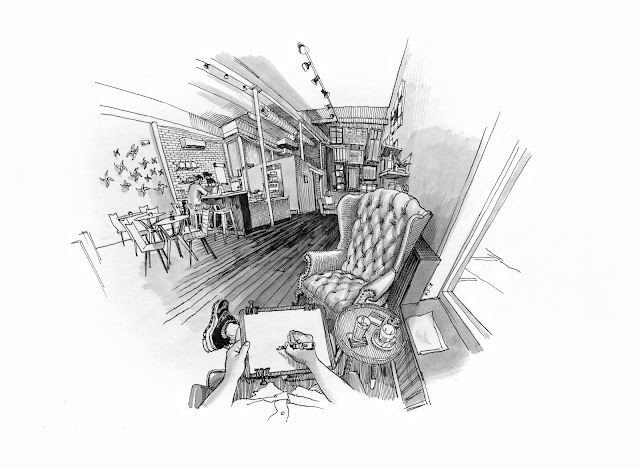When asked what kind of art I make, I say "I sketch what I see." That's it. I go out on location and sketch what I see. Or I stay home and sketch what I see. The "what I see" part is what's important to me. And that brings with it all sorts of other ideas to explore. Because what do we see, really?
My style of sketching is a mixture of a few different approaches to observational art-making. There's the still-life/in-studio tradition where the artist narrows their focus on just a small portion of their field of view. There's plein-air landscape painting, where often the goal is to widen the field of view as much as possible and take in sweeping vistas. There's architectural and perspective drawing, where the challenge is to effectively depict human-made spaces with their corresponding geometry in a convincing way. And there's figurative art, where capturing the human form in one way or another is the goal. You can find examples of each of these interests in my sketches.
Not long after I started sketching I realized I was having trouble with drawing space. It was hard to wrap my head around. I'm the kind of artist who is drawn to a problem like this. What was I missing? I learned the basics of linear perspective drawing in school, and I was more or less proficient. But applying those ideas to a live observational sketch made my drawing feel rigid and clinical. The sketch just didn't feel alive. So I started sketching as much space as I could. Interiors, exteriors, urban areas, landscapes. I found myself "zooming out" and trying to include as much space as possible in the composition.
In 2008 I started a project wherein I would draw all the buildings on Main Street in Bozeman, Montana from across the street, starting on one block and working my way down, then crossing the street and doing the other side.
As I went along though, the idea of making the top and bottom edges of these buildings horizontal wasn't making much sense, especially when I had to zoom out to capture a taller building. I could tell as I looked down the street that as the buildings got further away from the center of my field of view they got smaller. Which meant the street wall was "tapering" in either direction. Horizontal lines didn't cut it.
I was familiar with panoramic photos and the way space seemed to bend and curve in them, so I thought I'd try that with my drawings to see if it made them feel a little more dynamic and to showcase the diminishing scale as the buildings receded from the center of my field of view. It worked!
I started incorporating curved lines in almost all my sketches right there and then. Not just along the horizontal axis, but along the vertical, too. And I found it worked for interior sketches as well as exterior. I came to realize that as I widened my field of view, things that were normally cropped out would have to be visible, like my hands and sketchbook. My sketches began to look as if the viewer was in my head, looking at my world through my eyes. I've been doing this for over ten years now and haven't looked back.
The big question with sketching this way is do we really see these curves, or are they imagined? The answer to that question requires us to think about how we see anything. Think about how you gather information about your surroundings. Your eyes dart around a given environment thousands of times, focusing on numerous different points and assembling all the information in your brain into a "picture" of your location.
I wonder, have we trained our brain to assemble all that stuff a certain way because of certain things we learned early on? We are told lines are straight mathematically, but are they visually? I think I see the curves, but in the end it seems impossible to prove. Ultimately, I like playing with curving space in my drawings because I think your brain can assemble all that visual information any way you choose. And, well, it's fun.











This comment has been removed by the author.
ReplyDeleteThis comment has been removed by the author.
ReplyDeleteThis comment has been removed by the author.
ReplyDeleteNaturei provides you home safety and office supplies.Contains desktop glass dry erase board and concealment shelf.
ReplyDeleteCan you share some advice on specific exercises that I can do to train this skill in a natural sense? I know it takes a certain sense of failure to get at a decent enough level but how to structurally build the visual skill?
ReplyDeleteJust wanted to say I genuinely love your work and what you do. Please keep it up it's amazing. I'm currently analysing you're work for my GCSE final piece and it's been a massive inspiration. Thank you!!
ReplyDeletelol same for a -lveel tho ahahha
DeleteThanks for sharing this this knowledge
ReplyDeleteentertainment
it is sketches but, it's so good and beautiful!
ReplyDeleteIndiana Bowed Wall
Thanks for posting and discussion of the topic a brief history of how i started-to, and provide an important information. I really like this blog.
ReplyDeleteBest dental hospital in patna
Thank You and I have a swell offer you: What House Renovations Need Council Approval remodeling companies near me
ReplyDeleteI really enjoyed reading about your journey into drawing and how your passion developed over time. It's always inspiring to see how artists evolve and find their unique style through persistence and exploration. Your story reminded me of the importance of preserving creative work, whether it's sketches or old photographs. For those looking to bring new life to their cherished memories, professional photo restoration services can work wonders. They help maintain the integrity of historical or sentimental images while enhancing their visual appeal. Thanks for sharing your artistic path—truly motivating!
ReplyDeleteCool
ReplyDelete